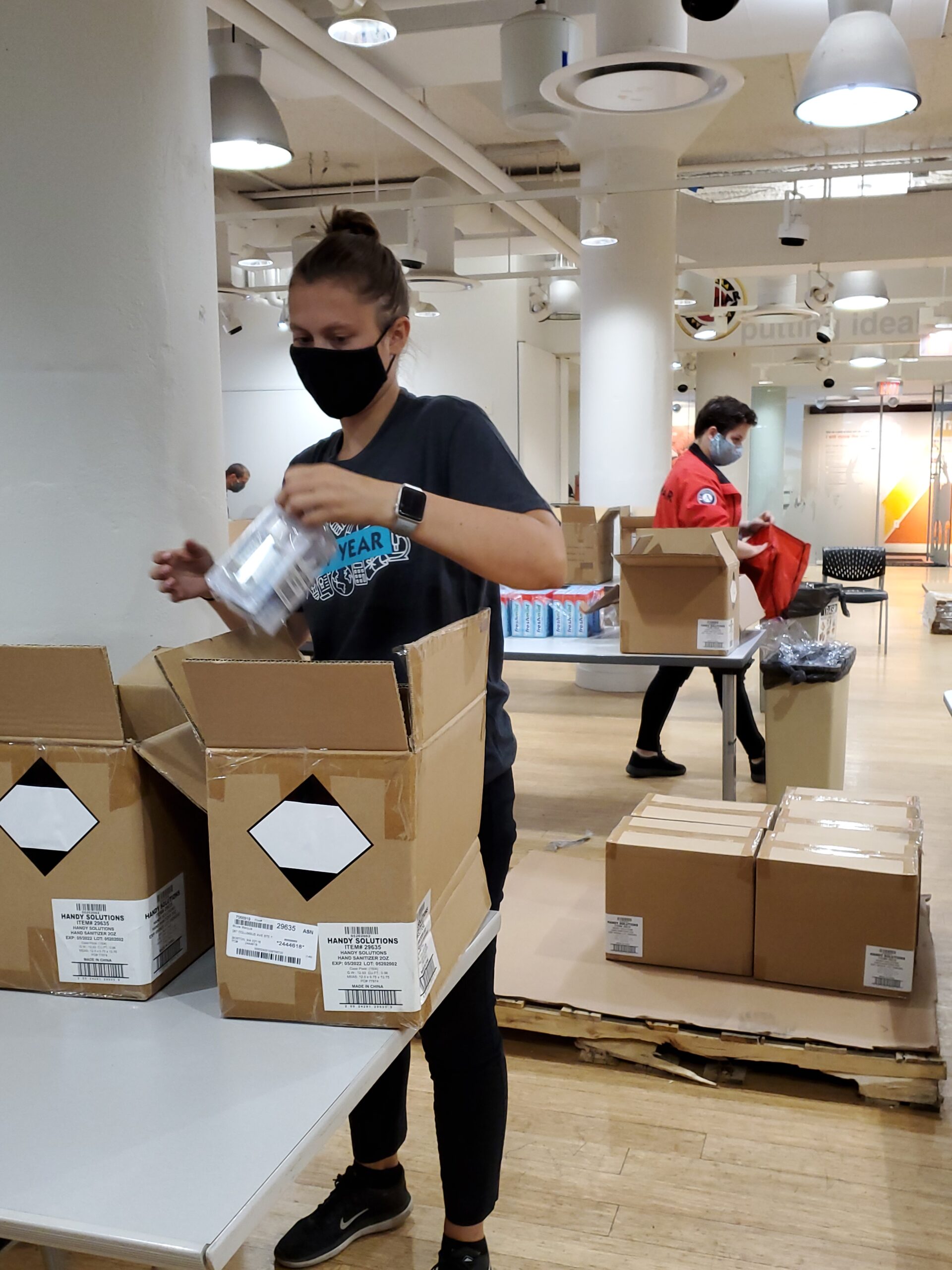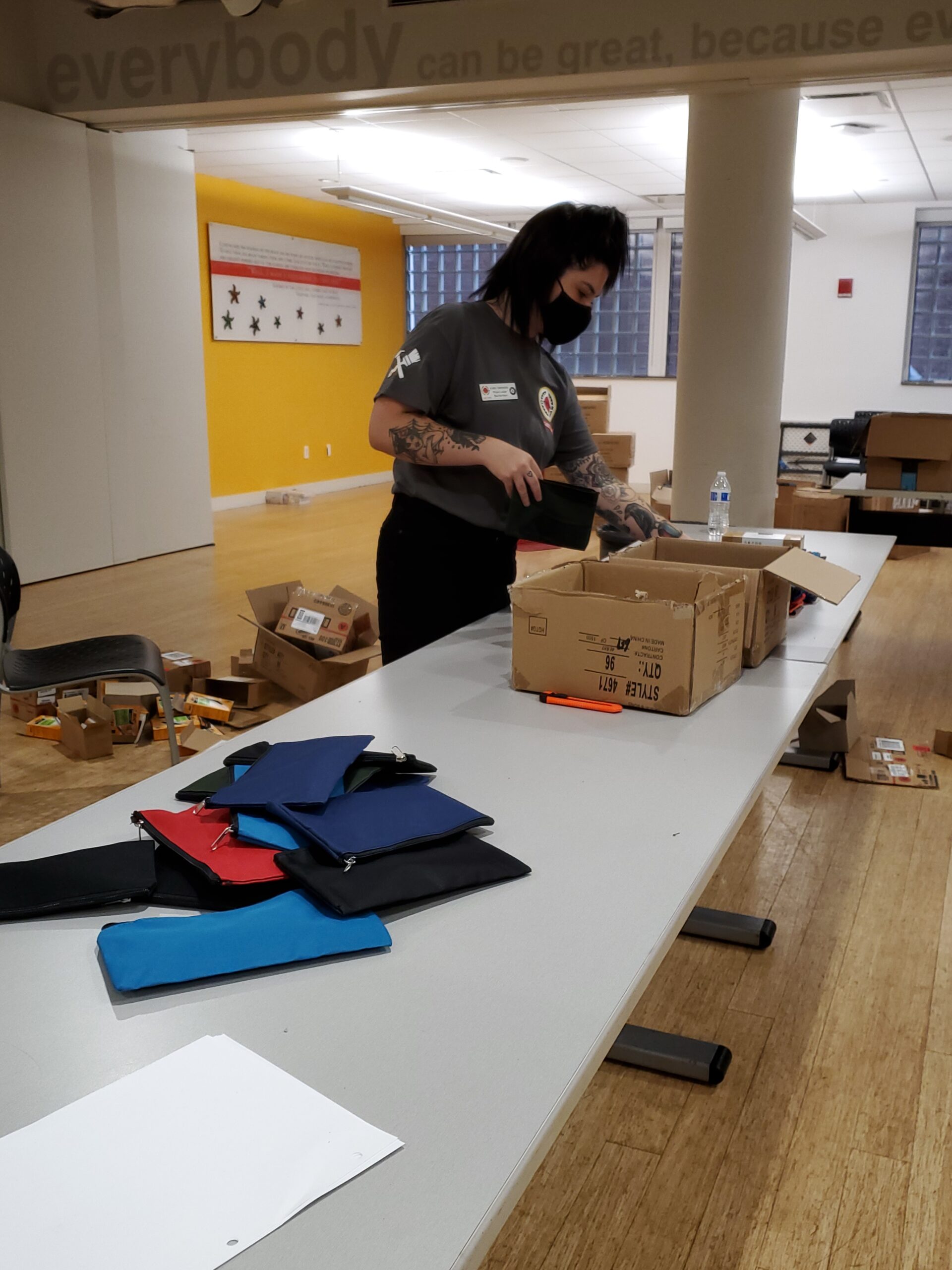The evolution of packing for virtual events- Our top takeaways
Our team has spent quite a lot of time in the Lavine Civic Forum of the City Year HQ this fall. We have been packing thousands of boxes to be sent to volunteers across the nation as we roll out virtual service opportunities. Since COVID-19 began and our usual in person events have come to a halt, we were tasked with finding alternate ways to engage our corporate partners. We started by packing and sending cinch sacks full of school supplies to four schools in Chicago, IL through a partnership with Aramark. During this initial process, we learned quite a bit, here are a few of the standouts:
- Packing works best as an assembly line (a socially distanced assembly line of course).
- Don’t stay on one task for too long. It may get comfortable, but its ultimately better to move around work to learn different parts of the packing process.
- It is important to work as a team and communicate, even more than you think you need to.
- Have a plan before you start, it makes the process go by much faster.
- Hold feedback discussions at the end of each day to improve for the next day.
- Always call the post office to let them know when you will be bringing in more than 50 boxes to be mailed in one day.
- Pre-print postage and tracking labels to save your postal worker from manually imputing those numbers once you get to the post office.

After the boxes for Aramark, we moved on from there to packing boxes for a series of seven virtual events that we ran in partnership with Vertex. For these events, we were joined virtually with employees across the globe. Primarily these employees sat in San Diego, Washington DC, Boston, Oxford UK and London UK. Care Force staff came up with a plan to make sure we were still able to partake in service events while staying socially distanced. This plan we called “create and ship.” Our team went into the office in two pods of four, to make sure we minimized exposure risks in order to pack the boxes that were sent to each volunteer. Each box was packed with materials the volunteer needed for service. For this event, volunteers decorated six pencil pouches and filled them with school supplies (the contents of the pouches varied by school and event). This event was very different than the first packing event because this time there was an element of volunteer interaction, we would lead them in designing pencil pouches over a series of Zoom calls. Also, the contents were different, but we were still able to apply what we learned from the first event. We even came up with a few more ideas to streamline our packing process:
- Quality control check each pouch and box as you go. It may seem like a lot, but it’s much better to check in the moment, so you don’t have to check later.
- Everyone on the team has a niche or specialty when it comes to packing. We learned quickly who to go to if we were trying to think over a better system, who would help carry boxes or who was the best when it came to organizing packed boxes.
- Care Force, Vertex and companies all over the globe are in an experimental phase in this pandemic. We do not need to be perfect, and it is important that we re-adjust and improve our technique as we work.
- It was easiest to pack when we had a station rotation system. This way everyone knew exactly what their job was for that specific station and everyone made sure to tidy up before moving on to the next task.
- Be flexible. Some things take time – getting names on boxes, acquiring postage, having supplies come in. Do your best with what you have and it will all come together.

Next, we moved on to packing boxes for a virtual event we ran for AT&T as part of their AT&T Believes At Home campaign. This event looked very similar to our “create and ship” event with Vertex, however this time we did not interact with the volunteers over Zoom. We were able to send the boxes to each volunteer and receive them back at the office when they had completed the service. Here are even a few more things we have learned that we get to apply to our future events:
- Fed Ex boxes can only be sent through Fed Ex, if you want to send those boxes with USPS you will have to run through multiple sharpies crossing out the logo.
- Nothing changes unless you initiate it. Each of us learned different things from our experiences while packing. We cannot expect for every member of the team to be on the same page with what needs to be improved in order to streamline packing. We learned that sitting down and explaining directly to supervisors what we were experiencing was most effective way to influence change.
- Create a packing communication channel somewhere, whether it be virtually through Microsoft Teams or email, or physically using a whiteboard. This will help ensure everyone is on the same page with the progress that has been made. It is especially important since not everyone is able to be in the office working together.
- When packing it’s best to count how many boxes you have completed as you go. Often times, we would pack boxes and set them off to the side without keeping track of how many we have done, then you would have to re-count.

Our last three events of 2020 were held on December 9th and 10th. We were able to partner with Aramark for their holiday event where we designed holiday cards with volunteers. These holiday cards were included in canvas bags full of toiletries, games, cold weather gear and more for families in need in Philadelphia, Dallas, Chicago and Nashville. We had most of the supplies sent to City Year Headquarters in Boston where our team worked to pack 300 canvas bags. This packing process was very different than events previously because there were far less team members able to join in the packing process due to quarantine restrictions, so our assembly lines looked much different. Using large bags instead of boxes also made a big difference as well. Even though all these events are very different, there is something to be learned from each of them.
- Assign a project manager from the team to learn, plan and explain the overall process of packing for one event to everyone else involved.
- Open every box you will need to open before the packing process starts.
- Quality check the items you receive to make sure none have been broken or lost in transit.
Related stories
Team Care Force member Andy Wilson shares some of his favorite things about traveling with Team Care Force.
Read more about My favorite things about traveling with Care ForceCare Force is proud to welcome seven new senior AmeriCorps members serving as project leaders on Team Care Force.
Read more about Welcome Team Care Force #16Team Care Force ventures to East Palo Alto, California, in their yellow City Year jackets to prep and lead a...
Read more about Emerson Collective at EPA BloomhouseIn October 2021, Noel Wuesthoff led Aramark volunteers in his first ever in-person event in Dallas and again a few...
Read more about Aramark Unites Against Poverty















